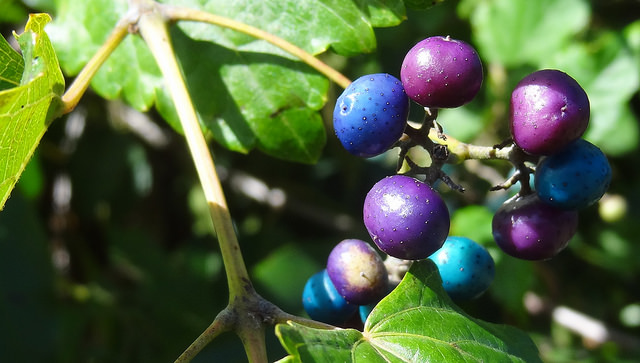Porcelain berry: an invasive eradicated in Ogdensburg?
A total lunar eclipse is likely more common than the swift removal of a novel invasive plant infestation, but fingers are crossed that such a thing happened in St. Lawrence County this summer. The plant eradication, I mean—we all know about the celestial event this past July, the first central lunar eclipse since June 2011. Thanks to the sharp eyes of Dr. Tony Beane, a Professor of Veterinary Science at SUNY Canton who is also an avid naturalist, an exotic vine capable of smothering fields and forests has been eliminated within weeks of its confirmation in the Ogdensburg area.

Porcelain berry. Photo: Matin LaBar, Creative Commons, some rights resrved
Commonly called porcelain berry (Ampelopsis brevipedunculata), there is nothing “brev” about the Latin name, nor the growth habit, of this aggressive woody vine which can quickly blanket vegetation along streams and forest edges, killing native plants and curbing regeneration. It is banned in most states and is listed as a “Prohibited Species” by the New York State Department of Environmental Conservation (NYSDEC), meaning it “cannot be knowingly possessed with the intent to sell, import, purchase, transport or introduce.” Sadly, web searches still turn up dozens of ads to buy this vine, even when “invasive” is added to the search parameters.
The discovery of porcelain berry in northern NY was relayed to the St. Lawrence-Eastern Lake Ontario Partnership for Regional Invasive Species Management (SLELO PRISM), a group composed of conservation groups, land trusts, and government agencies at various levels, whose goal is to limit the economic and environmental damage done by invasive plants, insects, and aquatic organisms. On the heels of the report, SLELO PRISM’s Early Detection Team made a site visit, and the plants have since been destroyed. The team plans to make follow-up visits over the next few seasons to scout for re-growth.
Native to Japan and parts of northern China, porcelain berry was first brought to the US around 1870 as an ornamental. It is related to our native wild grape, with which it can be easily confused. Unlike grapevine, which has shaggy bark and a brown pith, the porcelain berry vine has smooth, lenticeled bark, similar to that of buckthorn, and a white pith. The hard, multicolor berries for which it is named progress from lavender to green to bright blue as they ripen, and do not hang down like grapes, but are held erect. Porcelain berry leaves are often deeply 5-lobed as compared to grape leaves, which are generally 3-lobed and not as deeply incised, but this varies greatly and is a poor diagnostic feature.
Although the possible elimination of an invasive species never before seen in the North Country is heartening, people are urged to keep an eye out for porcelain berry. Its fruits are eaten by birds, and seeds from this one known population could easily have been carried to other locations in northern NYS. If you think you may have found this plant, please report it to your nearest Cornell Cooperative Extension or NYSDEC office. See the full list of NYSDEC Prohibited Species. For more information on controlling invasives in northern NYS, visit sleloinvasives.org.
Paul Hetzler is a horticulture and natural resources educator with Cornell Cooperative Extension of St. Lawrence County.
Tags: environment, invasive species, invasives, porcelain berry





.jpg)

